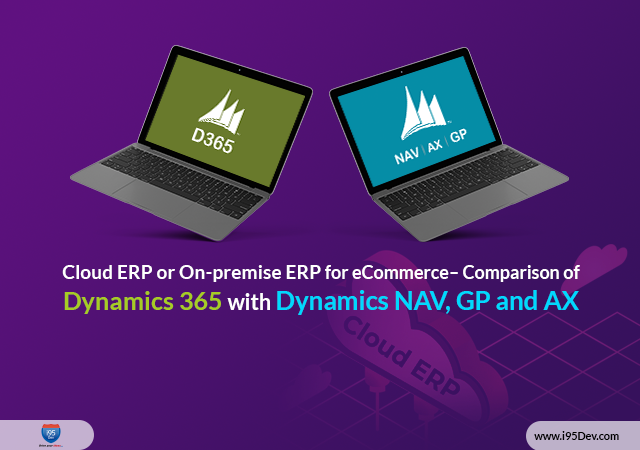Cloud ERP or On-premise
ERP for eCommerce

On-premise ERPs are ERP software installed locally in your organization using your infrastructure and your IT department manages it. However, cloud-based ERP systems, which are also termed as SaaS, or Software-as-a-Service, are managed centrally by the ERP provider and can be accessed using any web browsers by users. Let us either look at some numbers and statistics to understand why one should choose of the systems or move to cloud-based ERPs from the traditional ones.
- According to Forbes, by the year 2020, almost 70 percent of software, services and technology will switch to cloud-based
- In 2018, the adoption rate of new customers choosing cloud-based ERP was 80 percent over on-premise ERP
- The rate of growth of investing in cloud computing has increased by 4.5 times in the last decade
There are mainly two aspects, which clearly helps you differentiate between the two – type of deployment and pricing. Some of the other key factors you need to take into consideration whether to use on-premise or cloud-based ERP software is mentioned below:
Cost of Ownership
On-premise ERP system is charged as a one-off license fee by the service providers. Additionally, they need a large investment for setting up a dedicated infrastructure to manage the software, hardware, servers etc. You will have to bear the cost of hosting and maintenance. The IT team in your organization has to be trained to maintain the system on a daily basis. If your company does not have an IT team, you might as well have to invest to hire one. In the case when the ERP system needs an upgrade, the IT team should be capable enough to redeploy, customize and integrate with your existing systems at no extra cost. On-premise ERP is typically considered as a capital expense.
Cloud-based ERP systems are relatively less expensive. The initial cost is lesser than that of an on-premise one as all you need to invest is on the software and a few computers with a strong internet backbone. All other infrastructure requirements such as hosting are provided by the cloud-based ERP provider. There is no need for an IT team in your company as once the system gets running, the provider will maintain it and will ensure that data is secured or other daily operations are executed smoothly. Cloud-based ERPs mostly offer pay-as-you-go subscription plan as per your number of users. This helps you manage your cash flow and reduce unnecessary investments. Thus cloud-based ERP is typically considered as an operating expense and it can be as much as 46 percent less compared with an on-premise ERP system.
Maintenance and Software Updates
One of the major drawbacks of using on-premise ERP is that when your ERP provider releases a new update or enhances the software it becomes a difficult task for your IT team to upgrade to the newer version as all your previously implemented customizations wipe out. In that case, your IT team will have to reconfigure it from scratch. This is a reason companies are reluctant to upgrade their on-premise ERP. They continue their business with out-of-date technology. If you want to use an e-commerce solution, you might have to purchase from your ERP provider, as there will be a compatibility issue for integration.
Cloud ERP solutions such as Dynamic 365 or Dynamic NAV are continuously upgraded by the service provider. This allows your ERP to be updated with the latest version. In addition, the previously configured customizations and integrations are automatically carry forwarded after an update. In this case, your IT team does not get involved as the service provider maintains routine updates. You can also integrate e-commerce system such as Magento with your existing ERP.
Deployment and Implementation
Deployment of ERP is time-consuming, as it needs roughly a year to plan, gather resources, build the required infrastructure, and finally implement it on-premise. Comparatively, cloud-based ERP such as Dynamic 365 or Dynamic NAV takes lesser time to deploy and implement. It does not require any additional hardware and requirement or infrastructure is also minimum. Within a span of two to four months, a service provider can set it up and you can use it for your business. It is scalable and gives you the flexibility to add new users as your business expands. For on-premise ERP you need to invest in additional hardware if you plan to scale it up.
Connectivity and Integration
On-premise ERP will provide with a set of features out of which most would be useful to the business others you may not use them at all. As these features are already installed in the software, you will be unable to integrate additional functionalities you require.
On the other hand, cloud-based ERPs are designed to work with other systems using API connections. So if your business requires integration with an e-commerce system or custom EDI functionality, cloud-based systems allow you to achieve it.
Security
Data security plays a vital role in any business. On-premise ERP software has access to a limited number of users within the organization hence many people find it to be safe and secure. Although there is always a risk of a security breach or even infiltration in the workplace.
However, cloud-based ERP service providers take data security very strictly and therefore use trusted platforms such as Dynamic 365 and servers keeping your data safe and secure. They also provide you with regular backup of data to keep the software updated with the latest security measures.
While on-premise ERPs have contributed a lot to industrial growth across the world and verticals, they have run their course. Today, on-premise users are stuck with their current platform. eCommerce store owners must build their eco-system to accommodate rapid growth. Contact us to know more.



